David J. Thouless
Biographical
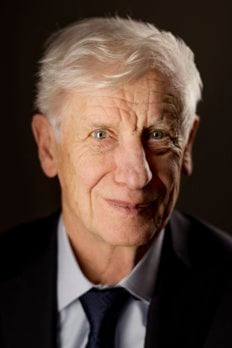
The Name
The name Thouless is very rare. Fewer than 150 people with the name live in Britain, almost all of whom are connected to Norwich. This is because it is a relatively new spelling of an old name spelt variously Thules, Thewless, Thewlis etc. Five generations before David, his ancestor John was born Thules. When John’s son, James, was born, both parents were illiterate and the clergyman filling out the baptism certificate wrote what he thought he heard – ‘Thouless.’ It seems that almost everyone with this particular spelling of the name is descended from James.
Mother’s Family Background
David’s mother was born Ella Grafton Gorton in 1898. She changed her name to Priscilla when she was studying in Italy, where she found that having a name that translated to “She” in Italian was inconvenient. The family name originates in Gorton, a suburb of Manchester. Her father’s family had been Church of England clergymen back into the 1600s and continued this tradition through her generation. Her grandfather, father, three of her brothers and two of her brothers-in-law were all clergymen. The most prominent of these was her brother Neville Gorton, the Bishop of Coventry who was deeply involved in building the new cathedral after the war.
Priscilla was the sixth of seven children. She was taught by a governess who did not like mathematics and influenced her pupil to feel the same way. After her father died, she went to Altrincham High School and then got a scholarship to Manchester University. She gained a BA and MA in literature and taught English at Manchester until David’s older sister Susan was born in 1925.
David’s generation, which included 14 first cousins on his mother’s side, were not involved with the church or science. The most notable of his cousins was Assheton Gorton, who was an artistic director of a number of well known films such as Blow Up and The French Lieutenant’s Woman.
Father’s Family Background and Scientific Interests
David’s father Robert Henry Thouless was born in Norwich in 1894. Robert’s father Henry James Thouless married Maud Harper from Devon who was studying at a Teacher Training College in Norwich. Henry James was a company secretary at Barnards, a Norwich engineering firm. However, his passion in life was natural history, with a particular interest in insects, specifically moths. He served a term as the President of the Norfolk and Norwich Natural History Society and had a bungalow on the edge of a marsh in Wroxham, which was ideal for finding insects. He bequeathed a collection of insects he had collected, which included two named after himself, to the museum in Norwich Castle.
Robert had two sisters, Sybil and Margaret. Sybil became a nun and taught school in the order of Notre Dame. The younger sister, Margaret, also became a teacher. She studied at Oxford University before they allowed women to take degrees. Once women were allowed to take degrees, she returned to study Latin for a year, as this was a requirement for graduation. Margaret had wanted to study science, but she was considered too frail to do the lab work required. Instead, she taught English literature and foreign languages at St. Mary’s Calne, a girls’ private boarding school.
David’s father Robert attended King Edward VI School in Norwich. In 1912 he went as a scholar to Corpus Christi College, Cambridge. In 1914 he was awarded a bachelor’s degree in natural sciences. He joined the Royal Engineers as a signaller. After a couple of years, in 1917 he went to the Salonika Front, from which by his account he was lucky to have come home alive. He became a lifelong pacifist but it did not stop him joining the home guard to defend his own town, Cambridge, during the Second World War.
After the First World War, Robert returned to Cambridge and did a PhD in psychology. He then became a lecturer at Manchester University before moving to Scotland to start the Psychology Department at the University of Glasgow. While at Glasgow, he did his most important work on how an object is perceived, introducing the term “phenomenal regression” in 1931. In the 1930s this was a very unfashionable line of research, and it did not enter mainstream psychology until the 1950s. Robert was offered the resources to study this phenomenon in Australia after he had retired, but he replied that he did not have the strength and brain power he had had when he wanted to study the topic 40 years earlier. David has followed his father’s originality of thought, which sometimes came before the rest of the world is ready to engage in a topic.
Robert Thouless was also known for his radio programmes on how to critically analyse flaws in reasoning and arguments, which he later turned into the book Straight and Crooked Thinking. This is known as How to Think Straight in the US. It has been a required textbook for many generations of students of rhetoric. His grandson Christopher Thouless has revised the last two editions, so it has been in print for over 85 years.
Later in life, Robert concentrated his research efforts on studies of the paranormal. He was elected President of the Society for Psychical Research in 1942. Although a frequent result of his painstaking investigations was the detection of cheating in apparent cases of psychic powers, he continued to believe in the possible existence of such abilities.
David’s Education with Emphasis on Mathematics
Even as a four year old, David was precocious in mathematics. One day, after discussing with his father how far counting goes, David decided to take the experimental approach. His family was bored by the time he reached 500 and even more bored by the time he reached the second thousand.
Just before his fifth birthday David and his sister were evacuated to his grandmother’s house in Devon at the outbreak of the Second World War. While there, David taught himself to read and write, with the help of his grandmother’s housekeeper.
As soon as it appeared that a German invasion would not happen immediately, David and Susan returned to Cambridge and David started school. At this point David stopped asking how to spell words and started thinking about arithmetic. With the aid of a simple abacus he worked out problems for himself. He worked out the 2 times table, working out what 2 times 27 was before he got bored with the project. At age 7 he set himself the task of working out how many seconds there are in a year. From age seven through eight, he spent two years as the only boy in the top class of the school, with the rest of the class being large 9- to 11-year-old girls, which was not a situation he enjoyed at that age. Much to his relief, his next school St. Faith’s was a boys’ prep school.
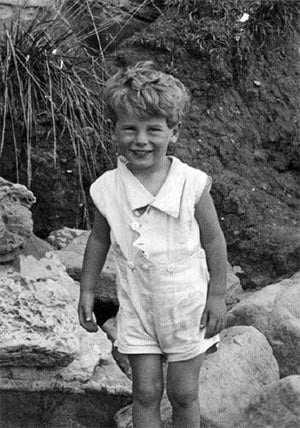
David’s father had a big influence on his intellectual development. “When I was 5 my father taught me to play chess, at which I slowly acquired competence but not brilliance. I think I was a teenager before I had a good chance of beating him at chess, but I was generally much better than my friends.” In fact David continued to play chess until he was in graduate school, when he felt the mental effort was too similar to physics. He and his friend played chess in their heads on long Territorial Army marches.
My formal education in science was close to non-existent until I was nearly fourteen. I can remember one young man trying to teach chemistry. Half the boys knew what he was talking about, but I had no idea why a chemical should go in one particular direction, rather than to any other end-product that had the same number of each atomic species. Fortunately my father was always willing and able to fill such gaps in my understanding.
I cannot enumerate all the things I learned from my father. He certainly told me about Wegener’s theory of continental drift, which was very unfashionable at that time. His enthusiasm for probabilistic reasoning was something he shared with me quite early; he was an early follower of Cyril Burt in stressing the importance of careful statistical analysis of psychological tests. He showed me how base 2 arithmetic could be used to win the game of Nim. I saw, but never really absorbed, the Boolean notation he used to solve problems in logic.
David met interesting visitors his father invited to the house. “A frequent visitor to the house in the early years of the war was the philosopher Ludwig Wittgenstein. My father had been to his lectures before the war, and there was an annotated copy of the Blue Book among his papers when my father died. I also found notes on a series of conversations on philosophical and scientific matters between Wittgenstein, my father and Cyril Waddington. These were published in 2003 by James Klagge and Alfred Nordmann in the book Ludwig Wittgenstein: Public and Private Occasions.”
Winchester
St Faith’s School in Cambridge encouraged David to compete for a scholarship to Winchester College. He was not sure he wanted to go, so his parents made alternative arrangements in case it should prove too stressful for him. He won the top scholarship of the year with an outstanding mathematics result and very good English and Latin. David had not studied Greek, so he did not attempt that paper. He was the first ever student to come top in the scholarship exam having only done three out of the four papers.
It was also decided that I should take the School Certificate at the end of the first year, despite the fact that I would still be thirteen, because in preparation for the introduction of O-levels in 1950, there would be a minimum age for School Certificate in 1949.
As a result of this I took the exams in English Language, English Literature, Mathematics, Further Mathematics, History (Ancient Greece), Latin, Greek and Divinity (including St. Luke in Greek). I was still struggling with Greek, quite enjoying the struggle, and got Credit in Greek, but got Very Good in all the other subjects. I had no official science background, nor any modern foreign language qualification. I did not take any serious external examination in foreign languages until I entered the Cornell Graduate School on my 22nd birthday.
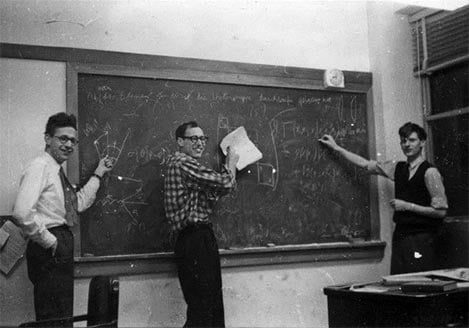
David got an excellent education in science at Winchester. “In all subjects there was a lot of emphasis on private study and assignments, and we spent relatively little time in class, perhaps less than eighteen hours a week, over about 36 weeks a year.” Time was found for a broad rounded education in addition to science. For example, “One of the joys of my second year was that the formmaster was Harold Walker, the head of the history department. His one-term course on American history left enough in my memory that I found no need to revise when I took the test for US citizenship. His scholarly but sceptical teaching of divinity was challenging and refreshing, particularly to someone like me who took religion rather too seriously.”
During David’s time at Winchester his termly reports did comment on his mathematical ability but expended far more space on his untidy work and handwriting. This may have led to his excellent habit of developing his equations on scrap paper and when he was satisfied with them copying them into hard backed numbered page note books. These have now been deposited in the archives of the Royal Society.
Cambridge University
David was fortunate that he did not get the scholarship he wanted to Trinity College, but did get one to Trinity Hall next door. Trinity Hall was a much smaller college, better suited to his introverted personality. He made a number of really good friends while there, some of whom he sees to this day. He became an honorary fellow of Trinity Hall in 2014 and enjoys participating in some of their activities.
Describing his undergraduate experience, he said:
I knew the Senior Tutor Charles Crawley well, as his son John was and is a good friend of mine. My own Tutor was the distinguished historian and theologian Owen Chadwick, and the other Tutor was Shaun Wylie, who supervised me in mathematics, and was probably the single most important influence on my academic development as an undergraduate. None of us were supposed to know the significance of Bletchley during the war and of Cheltenham later, but somehow or other, from various different sources, I had picked up a fair idea of what Shaun and his colleagues had been up to in those places.
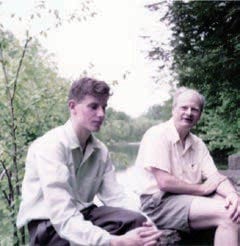
The other piece of good fortune was that Trinity Hall did allow David to defer military service until after he graduated, which Trinity College would not have done. This led into his later studies with Hans Bethe (Nobel Laureate, 1967). In June 1955, the Cavendish Professor Mott (later Sir Nevill) called David into his office and asked him what he was doing next. David said that he was going to do his military service, as he did not wish to defer until after graduate school because he did not want to do military research, which would have been the likely outcome once he had a graduate degree. Mott told him that he could continue to get a deferral as long as he continued his scientific work and that the requirement for compulsory military service was likely to be discontinued. This led to an interesting situation in which no one had time to take David on as a doctoral student but the Cavendish had money for a stipend for him. Professor Mott suggested that he work with Hans Bethe, who was on sabbatical at the Cavendish Laboratory, Cambridge University. After a year, Hans offered David the opportunity to go to Ithaca with him and study for a Cornell PhD, which David accepted.
Cornell University
David obtained a Fulbright Foundation scholarship, which paid for his Atlantic trip on the Queen Elizabeth ocean liner and a train trip on the Lehigh Valley railroad to Ithaca. He travelled with Ronnie Peierls, son of Professor Peierls (later Sir Rudolph) of Birmingham University, who was also going to Cornell to study with Hans Bethe. There were various students sitting at their dining table on the liner who were going to a variety of different universities. One of these kindly sent congratulations to David after the award of the Nobel Prize; even though they had not seen or contacted each other in the 60 years since the journey.
In David’s first week at Cornell he passed his modern language exams in French and German. He also passed the departmental qualifying examination with “flying colours.” He was particularly pleased as there were no required courses for physics graduate students in Cambridge and “Hans Bethe had been complaining about the poor knowledge of general physics shown by PhD students he had met in England.”
Cornell was unusual in having no graduate school course requirements, but the Physics Department required all its students to do two semesters of an experimental physics course. “I do not think any of my experiments came out right, but apparently the explanations I gave of what had gone wrong and what I needed to do about it were sufficiently convincing that I got the highest grade in the course, and was excused taking a second semester of experimental physics.”
While at Cornell, David met Margaret Scrase, a biology student in the College of Agriculture. They married and have now been together for 60 years.
Mathematician Mark Kac was on David’s doctoral committee and David said that “Getting to know Kac and to learn from him was one of the unexpected benefits of going to Cornell. I treasured his explanation of the difference between a physicist and a mathematician: that a physicist was interested in the simple properties of complicated systems, but a mathematician was interested in the complicated properties of simple systems.”
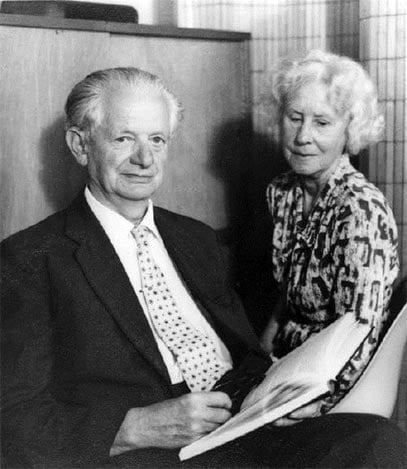
In the 1960s (according to John Rehr) a story went around the Cornell physics department that David asked Hans Bethe for a topic for his PhD and then showed up two years later with a completed thesis. The fact is that Bethe was a scientific advisor to President Eisenhower. He travelled back and forth by train from Ithaca to Washington D.C. every week, so it was hard for them to have regular meetings. David’s remark about this topic was, “if I had a good talk with him once a month, he left me with enough to think about for the next three months.” However there was some truth to the rumour. David did produce a finished thesis and ask for a year’s postdoctoral fellowship so that Margaret could finish her degree at Cornell. If David had shown Hans the thesis earlier the answer would have been yes, but as it was all of Hans’ money was committed so David had to look elsewhere. Instead he obtained a postdoctoral fellowship for a year at the Lawrence Radiation Laboratory in Berkeley, which allowed Margaret to complete her undergraduate degree.
Postdoctoral Fellowships
Cornell University had been such a marvellous experience for David and Margaret that whatever came next was bound to be a disappointment. David did not appear to have a preceptor in the Radiation Lab, but he did publish two papers and taught a course on atomic physics on the Berkeley campus which went quite well. Living in Berkeley was a pleasure and David and Margaret’s explorations of San Francisco, the surrounding hills and beaches and the Sierra Nevada would not have happened if either of them had been taking work more seriously.
David moved to the Department of Mathematical Physics at Birmingham University for two more years of postdoctoral research. He worked under Rudolf Peierls from 1959 to 1961. David was working very hard because there were a great many interesting physicists in Professor Peierls’ department in Birmingham University. David recollects, “I was probably more interactive with my colleagues during these two postdoctoral years in Birmingham than I was at any other period in my professional career.” David and Margaret’s two sons, Michael and Christopher, were born during this time.
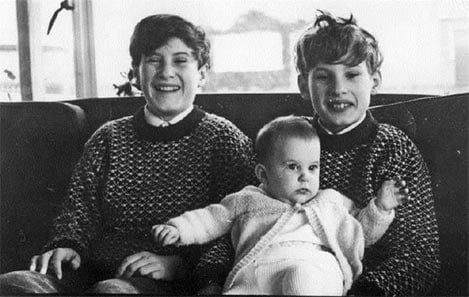
David spent the summers of 1960 and 1961 at the Niels Bohr Institute and Nordita in Copenhagen. These were a pleasure for all concerned and helped with the parlous financial state that resulted from trying to support a family on a British postdoctoral salary.
Cambridge: Churchill College fellow, university lecturer
David went to Churchill College as a Director of Studies and a Fellow in 1961, the first year the college took undergraduates. He also became a lecturer in the Department of Mathematics and Theoretical Physics. He learned a lot, particularly about teaching undergraduates, but he said there was less to show researchwise for the four years in Cambridge than in his previous positions. This had something to do with the intensive Cambridge 8 week term. He would get exhausted and spend much of the vacation recovering from respiratory diseases rather than doing research. His health only improved after the family moved into a centrally heated house in Birmingham in 1966.
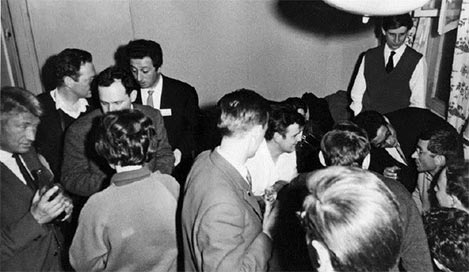
In March 1965, David went to an interesting conference in Novosibirsk. Russia had temporarily opened up and there were no Intourist guides in Novosibirsk. This allowed the Russian physicists to talk freely with the Western physicists.
In David’s own words:
In the early spring of 1965 the most memorable scientific meeting I have ever attended took place. This was a conference on many-body problems, which was held in Akademgorodok, about 20 km south of Novosibirsk. The town was the centre of work on nuclear physics, and had been closed to outsiders until that year. Teachers at the local English language school had been invited to translate for us, but Bogliubov told them they were not wanted, because it was better for the Russians to practice their bad English rather than to rely on teachers with good English and no understanding of physics. The teachers sat in on the sessions and in the intervals tried to talk to the few of us who spoke English from the right side of the Atlantic.
We were able to go for walks in small groups, unobserved by security people. We met with people like Abrikosov, Gorkov and Dzyaloshinsky, whose book was making my own book out of date. This meeting was the first occasion on which I met Vitaly Ginzburg, who later spent time in Cambridge, and came, with his wife, to visit us in Birmingham. I also got to know A. B. Migdal and V. M. Galitskii, who were the authors of the Paper on Green’s function that had been so in influential on my work at Cornell in 1958. An outing led, I think, by Migdal, was my first experience of cross-country skiing, in bright sunshine, but with crisp spring snow. The only unfortunate thing about this trip was that I had a bad cough, perhaps the remains of a pneumonia attack I had during the winter. I flew back as far as Sverdlovsk with a couple of young Russian physicists, but when we came back to the plane after a short walk I was accosted by a furious Intourist official, who was supposed to have been escorting me back to Moscow.
I spent two days in Moscow, visiting the Landau Institute and Moscow State University, hosted by Pitaevskii and by Abrikosov. One morning I wandered round the Kremlin by myself, and I was stopped by a guard, probably offended by my scruffy duffel coat. When I said I was “angliskii” he smiled broadly, waved his arms, and told me to look around. Unfortunately my first visit to Russia was probably also my last.
A couple of months later I happened to see Ginzburg and, if my memory is correct, Khalatnikov wandering around the Cambridge market place, during a break from a relativity conference. We invited them both home for dinner and got my colleague Roger Tayler to meet them. The third guest was a lucky choice, as he had translated one of Ginzburg’s books.
University of Birmingham Professor
In 1965 David was appointed professor of physics at the University of Birmingham.
He has left six pages of detailed notes about the development of his research during the first three years at the University of Birmingham and one year of sabbatical leave when he visited Chalk River, Cornell, Stony Brook and several places in Australia.
Before leaving Birmingham on sabbatical in 1968 Margaret loaned their only car, a Bedford camper van, to neighbours. When Margaret and David got back a year later the friends had moved to Bristol, taking the van with them. The husband was in South America and his wife had a new baby just when Margaret and David needed their car back, so David had to go and fetch it. He stopped and had lunch with John Ziman, then a professor at the University of Bristol, which changed the future of his physics research. Two of Ziman’s students said they had disproved Philip Warren Anderson and Nevill Francis Mott’s 1958 theory of electron localisation disorder, so David said he would look at their papers. In the end he convinced himself that Anderson and Mott were right; the Nobel Committee for Physics came to the same conclusion in 1977 when they awarded them the prize. The exercise of reading, analysing and rewriting Anderson and Mott’s work gave David opportunities to think about a topic that he had not thought about before and opened up connections within the physics world. David later thanked Margaret for changing the direction of his research life by lending their car.
Around 1970 Michael Kosterlitz, a research fellow whose funding was not tied to any particular project, began to work with David on the interaction energy of a pair of vortices in a two-dimensional neutral superfluid. David commented on their relationship, “We worked well together, since I had the broad ideas and tried to understand the big picture, whereas Mike would find the holes in my arguments and ways to solve the problems I had ignored.” This collaboration resulted in Kosterlitz-Thouless transition theory, described in their 1972 paper, which is one of two cited for the 2016 Nobel Prize in Physics.
The other events of significance in 1972 for Michael and David were the births of their daughters Karin Kosterlitz and Helen Thouless.
Reasons for Leaving Birmingham University
There has been a lot of discussion of the “brain drain” of the 1970s, which is often attributed to a lack of money for academics. However, David did not leave the UK for money, but because of difficulties with the university administration. When David arrived back in Birmingham from sabbatical leave in 1969 he had a meeting with the new Vice Chancellor, who asked David what he would be doing next. David gave the true but impolitic answer that he did not have any definite plans. This led to an ongoing saga which resulted in the Vice Chancellor eventually telling David that if he had a chance to leave the university he should do it.
Although David did not have any definite plans on returning from sabbatical, his curiosity and openness to new topics led to an extraordinarily fruitful period from 1970 through 1978. He published 16 of his most important papers in five distinct topics, including the work for which he was eventually awarded the Nobel Prize. As noted by Ana Mari Cauce, President of the University of Washington, David was known for his curiosity-driven research which, decades after the initial research, has led to many practical uses.
There were no theoretical physics chairs vacant in the UK at that time so David left the UK, much as he did not want to. David went briefly to Yale but clearly he did not talk adequately to whoever was in charge of making the appointment because Yale wanted David to build a research group, whereas David had always preferred to work with colleagues rather than being a group leader.
University of Washington Seattle USA
David’s life and work up to the year 1972 is known from his own detailed autobiographical notes. His story from that year forward is told without the benefit of such a first-hand account.
The University of Washington did not need David to build a big research group. There were enough other independent theoretical physics professors there to whom David’s students and postdoctoral fellows could talk if he were away. He mostly taught graduate students and upper class undergraduate courses. He had many graduate students from around the world, but never an American-born student.
Shortly after arriving in Washington in 1980, David wrote a grant proposal in which he described the work he intended to do, but also suggested he might investigate some entirely different topic if a more interesting one came along. David’s reputation for producing interesting work meant that he was awarded this grant despite the vagueness of the grant proposal; President Ana Mari Cauce has observed that this would be unlikely to be funded today, when grants driven mainly by curiosity do not get much support.
In 1982, David published a paper called Quantized Hall conductance in a two-dimensional periodic potential with research fellows Kohmoto, Nightingale and den Nijs (TKN2), which is the second paper cited for the Nobel Prize. The word topology is not mentioned in the title of the 1982 paper and does not appear in his titles until 1985. However, when David Thouless wrote the book Topological numbers in nonrealativistic physics in 1998 he said “Topological numbers crept up on the physics community before the community was aware of them. I did not think in these terms until I started working on the topological aspects on long range order in the 1970s, although I had been working on aspects of superfluidity that are not topological for several years before that.”
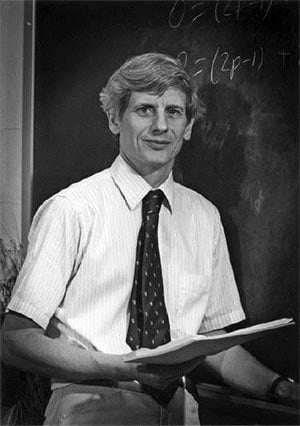
Marcel den Nijs has remained in Seattle and has been a great supporter of David but they have not published any more papers together.
In 1990 David was awarded the Wolf Prize in physics with Pierre-Gilles de Gennes (Nobel Laureate, 1991). Over the years he has received a number of other awards and honours. For example, he was elected a Fellow of the Royal Society (FRS) in 1979, a Fellow of the American Academy of Arts and Sciences (1981), a Fellow of the American Physical Society (1987) and a member of the US National Academy of Sciences (1995).
David enjoyed working and living in Seattle. He has never had many hobbies but he loved to hike in the mountains, camp, cross country ski and occasionally sail. His house had a 180-degree view of Lake Washington and mountains, including Mt. Rainier. Even though some of the surrounding trees have grown, a marvellous view remains. The garden faces southeast and has excellent soil for gardening. David’s biggest hobby over the years was reading. He read widely, but history interested him most. He was very happy in retirement reading in his chair and then resting his eyes on the view.
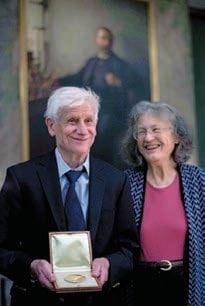
Assessing his own work, David wrote:
My scientific accomplishments as a graduate student and in postdoctoral positions had been very solid, with a successful book published, and several papers which were either novel or at least close to the latest work in the field. There was less to show for my four years in Cambridge. The work on the exchange mechanism for nuclear magnetism in solid 3He, inspired by Phil Anderson, was a substantial contribution, and taught me a lot, but it was more than twelve years after publication that the theoretical work became relevant to experimental measurements. The situation did not change immediately after I went to Birmingham, but my work, for various reasons, blossomed after I had been there for two years, and continued flourishing for the next twenty years or so.
The following are the papers David judged to be his most important work.
A. Papers on nuclear matter
D.J. Thouless. Application of perturbation methods to the theory of nuclear matter. Phys. Rev. 112 (1958) 906–22.
M.A. Thorpe and D.J. Thouless. Oscillations of the nuclear density. Nucl. Phys. A156 (1970) 225–41.
B. Papers on collective motion in nuclei
D.J. Thouless. Stability conditions and nuclear rotations in the Hartree-Fock theory. Nucl. Phys. 21 (1960) 225–32.
D.J. Thouless. Vibrational states of nuclei in the random phase approximation. Nucl. Phys. 22 (1961) 78–85.
D.J. Thouless and J.G. Valatin. Time-dependent Hartree-Fock equations and rotational states of nuclei. Nucl. Phys. 31 (1962) 211–30.
R.E. Peierls and D.J. Thouless. Variational approach to collective motion. Nucl. Phys. 38 (1962) 154–76.
C. Papers on statistical mechanics
D.J. Thouless. Critical region for the Ising model with a long range interaction. Phys. Rev. 181 (1969) 954–68.
D.J. Thouless. Long range order in one-dimensional Ising systems. Phys. Rev. 187 (1969) 732–3.
J.M. Kosterlitz and D.J. Thouless. Long range order and metastability in two dimensional solids and superfluids. J. Phys. C 5 (1972) L124–6.
J.M. Kosterlitz and D.J. Thouless. Ordering, metastability and phase transitions in twodimensional systems. J. Phys. C 6 (1973) 1181–1203.
D. Papers on superconductivity and superfluidity
D.J. Thouless. Strong coupling limit in the theory of superconductivity. Phys. Rev. 117 (1960) 1256–60.
D.J. Thouless. Perturbation theory in statistical mechanics and the theory of superconductivity. Annals of Phys. 10 (1960) 553–88.
D.J. Thouless. Critical fluctuations of a type II superconductor in a magnetic field. Phys. Rev. Lett. 34 (1975) 946–9.
G. Ruggeri and D.J. Thouless. Perturbation series for the critical behavior of type II superconductors near HC2. J. Phys. F 6 (1976) 2063–79.
D.J. Thouless, P. Ao and Q. Niu. Vortex dynamics in superfluids and the Berry phase. Physica A 200 (1993) 42–9.
D.J. Thouless, P. Ao and Q. Niu. Transverse force on a quantized vortex in a superfluid. Phys. Rev. Lett. 76 (1996) 3758–61.
M.R. Geller, C. Wexler and D.J. Thouless. Transverse Force on a Quantized Vortex in a Superconductor. Phys. Rev. B 57 (1998) R8119–22.
D.J. Thouless, M.R. Geller, W.F. Vinen, J.-Y. Fortin and S.W. Rhee. Vortex dynamics in the two-fluid model. Phys. Rev. B 63 (2001) 224504.
E. Papers on magnetism
D.J. Thouless. Exchange in solid 3He and the Heisenberg Hamiltonian. Proc. Phys. Soc. 86 (1965) 893–904.
D.J. Thouless, P.W. Anderson and R.G. Palmer. Solution of ‘Solvable model of a spin glass’. Phil. Mag. 35 (1977) 593–601.
J.R.L. de Almeida and D.J. Thouless. Stability of the Sherrington-Kirkpatrick solution of a spin glass model. J. Phys. A 11 (1978) 983–90.
D.J. Thouless, J.R.L. de Almeida and J.M. Kosterlitz. Stability and susceptibility in Parisi’s solution of a spin glass model. J. Phys. C 13 (1980) 3271–80.
D.J. Thouless. Spin glass on a Bethe lattice. Phys. Rev. Lett. 56 (1986) 1082–5.
F. Papers on electrons in disordered systems
D.J. Thouless. Anderson’s theory of localized states. J. Phys. C 4 (1970) 1559–66.
J.T. Edwards and D.J. Thouless. Regularity of the density of states in Anderson’s localized electron model. J. Phys. C 4 (1971) 453–7.
B.J. Last and D.J. Thouless. Percolation theory and electrical conductivity. Phys. Rev. Lett. 27 (1971) 1719–21.
D.J. Thouless. A relation between the density of states and range of localization for one dimensional random systems. J. Phys. C 5 (1972) 77–81.
J.T. Edwards and D.J. Thouless. Numerical studies of localization in disordered systems. J. Phys. C 5 (1972) 807–20.
D.J. Thouless. Localization distance and mean free path in one-dimensional disordered systems. J. Phys. C 6 (1973) L49–51.
R. Abou-Chacra, P.W. Anderson and D.J. Thouless. A self-consistent theory of localization. J. Phys. C 7 (1974) 1734–52.
R. Abou-Chacra and D.J. Thouless. Self-consistent theory of localization: II. Localization near the band edges. J. Phys. C 7 (1974) 65–75.
D.J. Thouless. Electrons in disordered systems and the theory of localization. Phys. Reports 13 C (1974) 93–142.
D.C. Licciardello and D.J. Thouless. Constancy of minimum metallic conductivity in two dimensions. Phys. Rev. Lett. 35 (1975) 1475–8.
D.C. Licciardello and D.J. Thouless. Conductivity and mobility edges for two-dimensional disordered systems. J. Phys. C 8 (1975) 1803–12.
D.J. Thouless. Maximum metallic resistance in thin wires. Phys. Rev. Lett. 39 (1977) 1167–9.
D.J. Thouless. Percolation and localization. In Ill condensed matter, ed. R. Balian, R. Maynard and G. Toulouse (North-Holland 1979), pp 1–62.
D.J. Thouless. The effect of inelastic electron scattering on the conductivity of very thin wires. Solid State Commun. 34 (1980) 683–5.
G. Quantum Hall effect and related topics
D.J. Thouless, M. Kohmoto, M.P. Nightingale and M. den Nijs. Quantized Hall conductance in a two-dimensional periodic potential. Phys. Rev. Lett. 49 (1982) 405–8.
D.J. Thouless. Quantization of particle transport. Phys Rev. B27 (1983) 6083–7.
D.J. Thouless. Band widths for a quasiperiodic tight-binding model. Phys. Rev. B28 (1983) 4272–6.
D.J. Thouless. Wannier functions for magnetic sub-bands. J. Phys. C 17 (1984) L325–7.
Q. Niu, D.J. Thouless and Y.S. Wu. Quantized Hall conductance as a topological invariant.Phys. Rev. B 31 (1985) 3372–7.
Q. Niu and D.J. Thouless. Quantum Hall effect with realistic boundary conditions. Phys. Rev. B 35 (1987) 2188–97.
D.J. Thouless. Scaling for the discrete Mathieu equation. Commun. Math. Phys. 127 (1990) 187–93.
D.J. Thouless and Y. Gefen. Fractional quantum Hall effect and multiple Aharonov-Bohm periods. Phys. Rev. Lett. 66 (1991) 806–9.
D.J. Thouless. Edge voltages and distributed currents in the quantum Hall effect. Phys. Rev. Lett. 71 (1993) 1879–82.
H. Mesoscopic systems
Y. Gefen and D.J. Thouless. Zener transitions and energy dissipation in driven systems. Phys. Rev. Lett. 59 (1987) 1752–5.
Books
D.J. Thouless. The quantum mechanics of many-particle systems. Academic Press, New York and London, 1961; second edition, 1972.
D.J. Thouless. Topological quantum numbers in nonrelativistic physics. World Scientific Publishing Company, Singapore, 1998.
Note: Much of this biography is based on David’s words written in his own detailed autobiographical notes.
Thank you to Christopher Thouless, Michael Thouless and Peet Sasaki for making substantive comments and editing.
Biography by David, Margaret and Helen Thouless
This autobiography/biography was written at the time of the award and later published in the book series Les Prix Nobel/ Nobel Lectures/The Nobel Prizes. The information is sometimes updated with an addendum submitted by the Laureate.
David J. Thouless passed away on 6 April 2019.
Nobel Prizes and laureates
Six prizes were awarded for achievements that have conferred the greatest benefit to humankind. The 12 laureates' work and discoveries range from proteins' structures and machine learning to fighting for a world free of nuclear weapons.
See them all presented here.
